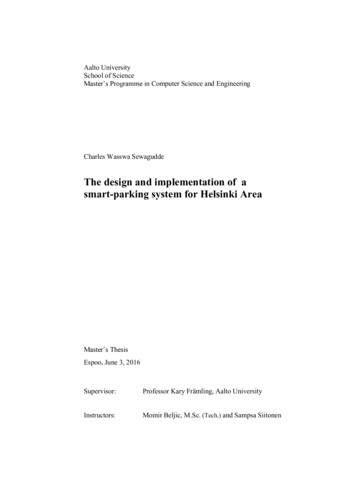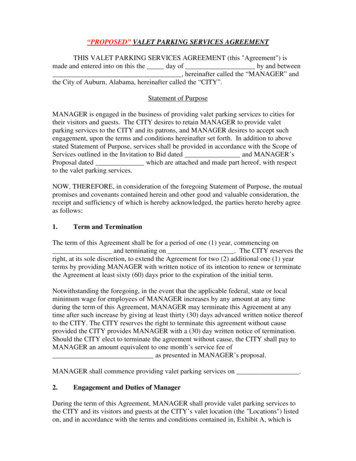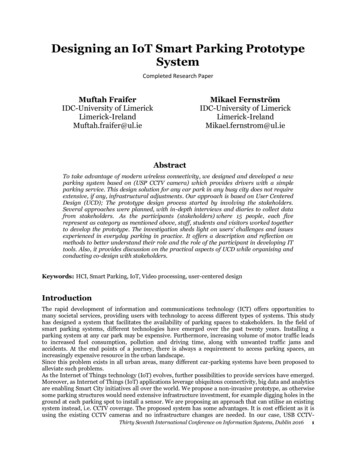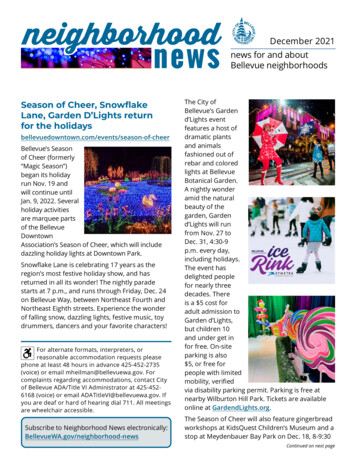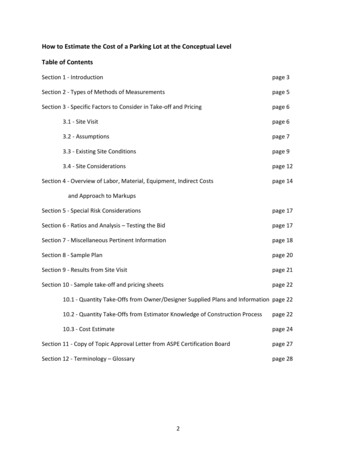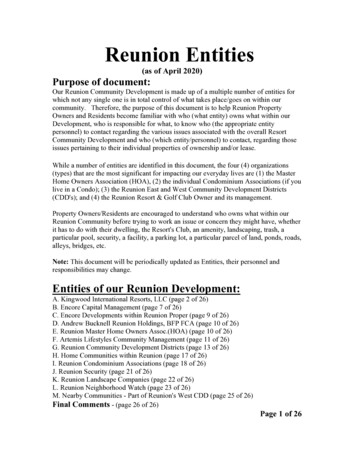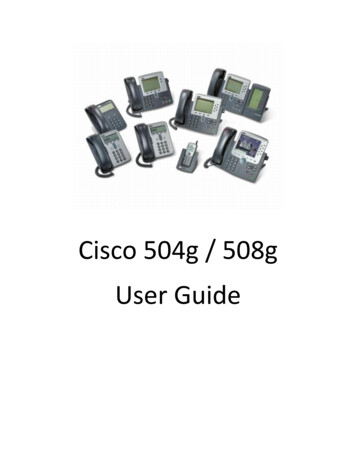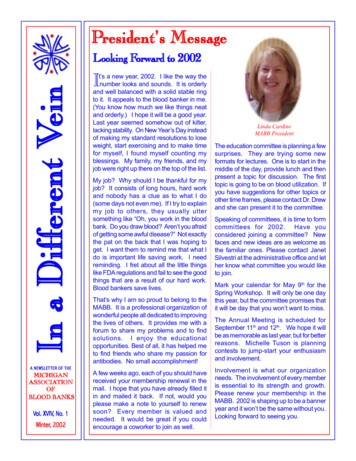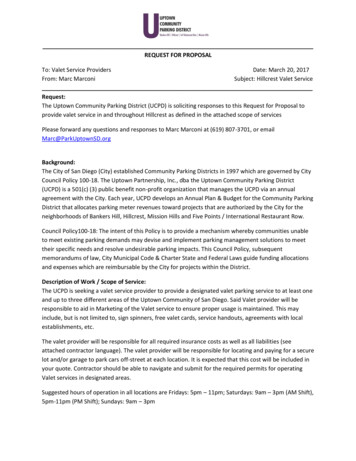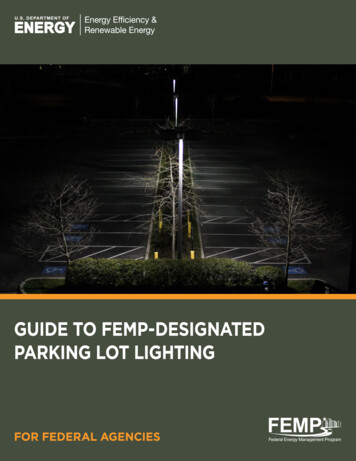
Transcription
TABLE OF CONTENTS1INTRODUCTION FEMP-DESIGNATED PRODUCTS ENERGY EFFICIENCY METRICS3DESIGN PROCESS STEP-BY-STEP OVERVIEW6COMPONENTS OF THE DESIGN DESIGN CONSIDERATIONS LIGHTING DESIGN CONSIDERATIONS LUMINAIRE DISTRIBUTION COLOR QUALITIES LIGHT SPECTRUM13PARKING LOT LIGHTING DESIGN DESIGN SCENARIO OVERVIEW DESIGN SCENARIO – GENERAL LUMINAIRE DESIGN SCENARIO – FEMP-DESIGNATED LUMINAIRE17LIGHTING CONTROLS SAVE ENERGY STATIC CONTROLS MULTI-LEVEL CONTROLS20COST-EFFECTIVENESS21RESOURCES
PARKING LOT LIGHTING GUIDEINTRODUCTIONLegislation and the Federal Acquisition Regulations (FAR) require federal agencies to specify and buy ENERGYSTAR qualified products or, in categories not included in the ENERGY STAR program, products that meet orexceed efficiency requirements designated by the Federal Energy Management Program (FEMP). Agenciesthat follow requirements to buy efficient products can realize substantial operating cost savings and reducepollution. As the world’s largest consumer, the federal government can help lead the entire U.S. market toachieve greater energy efficiency while saving taxpayer dollars.FEMP provides acquisition guidance and federal efficiency requirements across a variety of product categories,including outdoor pole-arm-mounted area and roadway luminaires, which are a FEMP-designated productcategory. Federal laws and executive orders mandate that agencies meet these efficiency requirements inall procurement and acquisition actions that are not specifically exempted by law.The purpose of this guide is to explain in greater detail the FEMP-designated outdoor pole/arm-mountedarea and roadway product category, to show how the equipment can be used to maximize total energyefficiency (using the metrics defined below), and to provide an estimate of the cost effectiveness of usingFEMP-designated products.ENERGY EFFICIENCY METRICSThere are different energy efficiency metrics. Although there are several metrics to describe energy efficiency, here we consider three lighting-specific metrics: efficiency (very simple), efficacy (simple), andlighting power density (complex). This guide primarily focuses on efficacy, and demonstrates how efficacyincorporated with other elements can reduce power densities.EfficiencyEfficiency is a measure of how effectively a device converts input into output. Luminaire efficiency (LE) isthe light leaving the luminaire divided by the light generated by the bare lamp (light bulb) when operatedoutside of the luminaire. Because both values (the light leaving the luminaire and the light generated by thelight source[s]) have the same unit, luminaire efficiency is therefore a unitless ratio.EfficacyEfficacy is the capacity to produce an effect. In lighting, efficacy is measured in lumens per watt (lm/W, alsoabbreviated LPW). Efficacy can apply to light sources or luminaires. The greater the efficacy, the more light isgenerated for the same watts. Most people are familiar with this metric related to vehicles; for example, a carthat gets 30 miles per gallon is more efficacious than a car that gets 25 miles per gallon.FEMP’s designated product for lighting focuses on luminaire efficacy and uses the term luminaire efficacyrating (LER). The following page explains how to calculate the LER as well as the relationship between luminaire efficiency and luminaire efficacy.A key note regarding efficacy is that it counts the emitted lumens irrespective of the direction in which theyare emitted, or the usefulness of those lumens. A luminaire can have a lower LER but do a better job of distributing light to an identified task.Lighting Power DensityLighting power density (LPD) is the total input power (i.e., including the driver or ballast) multiplied by the totalnumber of luminaires divided by the area in which the equipment is installed. Many energy codes use thismetric; however, it does not actually focus on energy. Energy is power multiplied by time, so it is importantto distinguish between power (watts) and energy (watt-hours). Lighting power density calculations do notindicate any energy savings as a result of the use of lighting controls.1
2PARKING LOT LIGHTING GUIDEFEMP-DESIGNATED PRODUCTSAs of September 2013, there are FEMP-designated products for lamps (light bulbs), ballasts, interior fluorescent luminaires, industrial high-bay luminaires, and many exterior luminaires. The metric for luminaires isthe LER. The following provides the LER value for parking lot luminaires (classified within FEMP as outdoorpole/arm-mounted area and roadway luminaires) as well as helpful calculations.FEMP REQUIREMENTS FOR PARKING LOT LUMINAIRESOutdoor pole/arm-mounted area and roadway luminaires must have an LER of 65 to be FEMP-designated(as of the date of this publication; the most current value as well as FEMP-designated products can befound at Covered Product Category: Exterior Lighting). The following explains how to calculate LER forconventional light sources such as fluorescent, metal halide, and induction lighting, as well as light-emittingdiode (LED) luminaires.LER total light leaving the luminaireinput powerConventional LuminairesConventional luminaires (non-LED) can use different combinations of lamps, ballasts, and optics; oftenrequiring LER to be calculated. If an LER is not available, buyers may estimate the LER using this formula:LER luminaire efficiency x lamp lumenslamp ballast input wattsLE x lamp lumens, and lamp ballast (system) input watts are typically found in manufacturers’ productcatalogs and photometric reports.The LER formula may be used with generally available component performance data to determine the minimum performance of other components. For example, known values may be used to calculate the lowestLE necessary to meet an LER requirement:A 200-watt high-pressure sodium (HPS) lamp produces 22,000 initial lumenswith 230 lamp ballast input watts. What LE is necessary to meet the minimumrequired LER of 65?LE LER lamp ballast input watts lamp lumens65 lm/W 230 W22,000 lumens 0.68Therefore, for a minimum required LER of 65, a fixture combined with the lamp and ballast values providedmust have an LE of at least 68%.LED LuminairesLED luminaires are available in different combinations, but their values are reported for the complete luminaire, not the light source by itself. The complete LED housing includes the fixture, light source (or lamp),and driver (similar to a fluorescent ballast). If an LER is not available, buyers may calculate the LER for LEDluminaires using this formula:LER luminaire light output (lumens)input power (watts)
DESIGN PROCESSThe rest of this document will explain options for energy efficient lighting in parking lotsusing FEMP-designated luminaires and features accounting for both lighting qualityand energy efficiency. Selecting energy efficient equipment, such as FEMP-designatedequipment, is the first step in energy efficient parking lot lighting. This section addressa step-by-step process from surveying the site to installation. Key points of the followingdesign process section include:1. Developing an inventory of equipment2. Determining lighting quality and quantity needs3. Incorporating lighting controls4. Addressing cost effectiveness in the process
4PARKING LOT LIGHTING GUIDESTEP 1: CONDUCT COMPLETE INVENTORYConsider all lighting opportunities and list the luminaires that you want to replace,and ask why you want to replace them. Is energy the only issue? If this is a retrofit,be sure to collect information on each luminaire that you want to replace (e.g., lamptype(s), mounting height of luminaires, general lighting information). Please note,entrances to the parking lot and areas near the building may use different luminairetypes than basic parking areas.STEP 2: CONSIDER LIGHT QUANTITY AND QUALITYThe lighting for a parking lot is dependent upon the type of building or site thatit supports as well as the surrounding area of the site. A parking lot at a nationalpark should not have the same lighting requirements as a secure federal facility.The Illuminating Engineering Society of North America (IES) recommends lightlevels for basic parking lots and higher light levels for parking facilities whereenhanced security is required. More light does not equal better quality. Mostsecurity cameras are rated for both very low and very high light levels, but arelimited by contrast ranges. Therefore, uniform lighting will aid in viewing imageson the camera as well as those physically in the parking lot.Lighting uniformity on the pavement surface must also be considered for safevehicle and pedestrian interaction. Too much contrast between bright and darkerareas makes it more difficult to see people and vehicles in the darker areas. Theuse of luminaires that distribute light evenly on the parking surface and lightinglayouts with appropriate spacing, are crucial to the lighting design. Consequently,one-for-one replacement may not be an option when specific light levels and uniformity ratios are targeted. Factors such as trees and other elements on the sitemay affect the lighting design. You can refer to IES resources or your local lighting professional for assistance. Contact the International Association of LightingDesigners and/or the IES to locate lighting professionals.STEP 3: CONSIDER CONTROLS FOR ADDITIONAL SAVINGSMost parking lots are lighted for 13 hours per day; lighting controls can be usedto save energy at times of infrequent use. Parking lots are often empty during certain periods at night; using controls to reduce the lighting during these periodswill help save energy. Consider circuiting the luminaires on the site so certain luminaires can be either reduced in output or turned off during periods of inactivity.For example, luminaires along the perimeter could be reduced to direct users topark closer to the building during evening operation hours. Light levels can bereduced by switching off every other luminaire or selecting bi-level operation asa feature at the time of installation. To maximize energy savings potential and usersatisfaction, luminaire selection, lighting controls, and installation have to be considered during the design phase and not as an afterthought.
PARKING LOT LIGHTING GUIDESTEP 4: SOLICIT BIDSAfter selecting the right technology for your parking lot, and specifying theappropriate lighting systems and layout to deliver lighting quality and quantity, a request for proposal can be prepared. (See resources at the end of thisguide for information about selecting the right technology.)STEP 5: COST-EFFECTIVENESSOnce you have pricing and cost inputs from several sources, you can evaluatethe cost-effectiveness including simple payback period, return on investment,life-cycle cost analysis, and savings-to-investment ratio. This will allow youto make the appropriate final decision. Free calculators and life-cycle costanalysis tools are offered by FEMP and by various product manufacturersand utility programs. Example cost-effectiveness calculations are providedat the end of this guide.STEP 6: PURCHASE AND INSTALLClearly identify required specifications and warranties in your purchase orderor contract. Most parking lot lighting systems will not require commissioning unless controls are involved. If controls are involved, be sure to identifywho is responsible for commissioning before signing the purchase order.Lastly, remember to file for any utility incentives within the required periodof time after project completion.Figure 1. A pole andluminaires beingremoved and replacedwith new equipment.CONSTRUCTION TIPParking lot retrofits can be done in increments, assumingthat the existing pole locations will be reused. The costsof trenching to provide power to the poles, foundation forthe poles, and the poles themselves can often exceed thecost of the luminaires. If possible, reuse the pole locationand even the poles to save money in a retrofit.5
COMPONENTS OF THE DESIGNThere are many components that have to be considered before the design process canoccur. The parking lot design coupled with the features of the luminaire (distribution,color, etc.) and how the luminaires are placed around the lot all affect the energy usageof the lighting system. Significant components of the design section include:1. The effects of the design of the lot including materials or canopie2. How light levels and color qualities affect the design and energy usage3. A review of different luminaire distributions4. Consider light spectrum for given exterior application
PARKING LOT LIGHTING GUIDE7DESIGN CONSIDERATIONSThe energy used to light a parking lot is not only affected by the luminaire(s)selected, but also by the design of the parking lot. Factors such as materialsused to construct the parking lot surface can affect lighting in the lot. Considerations made during the lighting design process addressing horizontaland vertical surfaces affect the energy usage and lighting in the lot. Additionally, solar canopies can provide on-site energy and open up new lightingopportunities, both of which save energy.Material SelectionAlthough materials in a parking lot can affect the lighting, they are not alwaysfactored into the lighting or energy calculations. Many sites incorporate treesand other vegetation into the lighting design. When doing so, it is importantto not only coordinate luminaire placement with the tree locations, but alsoto account for future growth of the tree canopy or trees. It is also importantto remember that deciduous trees will have different amounts of foliagedepending on the time of year. Both the foliage and the tree itself canobscure the light and potentially waste energy (see Figure 2).Lighting Vertical SurfacesParking lot luminaires do a good job of lighting the horizontal parking surface.However, the parking surface is not visible to drivers entering the parkinglot or from some parts of the parking lot. Consider lighting vertical elements—signage, architectural/sculptural pieces, solid landscape features, or thefaçades of the building itself. Lighting vertical elements and the façademakes the site more visually interesting, provides a destination for users ofthe parking lot, and makes the site feel brighter compared to sites that onlylight horizontal surfaces.Figure 2. Tree foliage can blocklight from luminaires.Solar CanopiesA growing trend in parking lots is to install solar canopies over a portion of theparking lot. A solar canopy creates covered parking for vehicles, and the topside of the canopy incorporates a photovoltaic (PV) panel. Therefore, in additionto sheltering users of the parking facility from rain and snow, the canopy cancreate on-site renewable energy to power parts of the adjacent buildings oreven charge electric vehicles. The solar canopy also offers a lighting opportunity,providing a mounting location that is easily accessible from a ladder or a smalllift (see Figure 3). Also, the lower mounting height means that a lower output(and thus lower power) luminaire is needed because the light is closer to theparking surface. As of July 2013, Tucson International Airport is in the processof installing a solar canopy to cover the parking lot in front of the main terminal. Solar canopies are not limited to the Southwest (though the climate is idealfor the canopies); they are in fact being installed across the country, includingin the Northeast, and by both commercial and municipal organizations.Figure 3. A parking lot recentlyretrofitted with covered parking.The covering incorporates PVpanels that supply renewableenergy to the site. Luminairesare mounted to the supportstructure for the PV panels.
8PARKING LOT LIGHTING GUIDELIGHTING DESIGN CONSIDERATIONSLighting a parking lot involves more than just using high-efficiency equipment. Multiple choices needto be made regarding the lighting and the desired results, including:a. Luminaire distribution – the direction and intensity of the light leaving the luminaire. Page 9 of thisdocument characterizes different typical distributions and how they affect the lighting design.b. Color qualities – the color of the lighting and how things appear in the space matters as much asthe amount and types of lighting in the space. Page 11 addresses basic color qualities of lighting.c. Luminaire Layout – where the efficient equipment is placed is as important as how it is used.d. Desired results – most lighting recommendations or requirements start with illuminance. This isthe amount of light falling on a horizontal or vertical surface (lumens per square foot or squaremeter). The metric used to measure illuminance in the U.S. is the footcandle (fc), which is onelumen per square foot. The corresponding metric system unit is one lux (lx), which is one lumenper square meter. One footcandle is approximately equal to 10 lux.The current guidance from the IES, which is referenced by most federal design requirements (including themilitary Unified Facilities Criteria), is RP-20-98. It is expected that RP-20 will be updated in the near future.RP-20-98 recommends a minimum illuminance (horizontal and vertical) for different conditions in theparking lots. In addition to the minimum values, RP-20 also recommends uniformity ratios. RP-20 focuseson the ratio of maximum to minimum illuminance values and tries to limit extreme ranges of illuminancevalues. Table 1 provides the current IES lighting recommendations, although these may change in the nextiteration of RP-20. RP-20 also provides guidelines for taking lighting measurements and what factors(e.g., shadowing, light loss factors) that should be included in the calculations.Table 1. RP-20-98 Parking Lot Illuminance Recommendations.Basic1Enhanced Security2Minimum Horizontal Illuminance0.2 fc0.5 fcUniformity Ratio, Maximum to Minimum20:115:1Minimum Vertical Illuminance0.1 fc0.25 fc1Fortypical conditions. During periods of non-use, the illuminance of certain parking facilities may be turned off or reduced to conserve energy. If reduced lighting is to be used only for property security, it is desirable that the minimum horizontal illuminancevalue be at least 0.1 fc.2Ifpersonal security or vandalism is a likely and/or severe problem, a significant increase of the Basic level may be appropriate.RP-20-98 recommends that additional analyses of a subset of points be computed (see RP-20 for moreinformation). In addition, for preliminary design RP-20-98 recommends an average horizontal illuminancevalue of 1 fc (basic) or 2.5 fc (enhanced security) be calculated. Regarding preliminary design, RP-20-98states that a 5:1 average-to-minimum ratio is the first step toward directing the design to achieve the maximum to minimum ratios presented in Table 1. Computer software allows for computing average, maximum,and minimum values and even a specified range of values. The scenarios in this FEMP guide show the percent of calculation points between 1 and 5 fc. If the design is for average overall illuminance of 1 fc, thehigher the percentage of points in the range between 1–5 fc means that this design intent is being achievedand the average is not being skewed by any extreme values. Ideally, more than 80% of the points will be inthe desired range.
PARKING LOT LIGHTING GUIDELUMINAIRE DISTRIBUTIONThe minimum FEMP-designated luminaire efficacy rating is only one aspectof energy efficient design. Distribution can be more important than the LERof a luminaire. FEMP does not state a minimum requirement or characterizedistribution because the necessary luminaire distribution is affected by thedesign of the space, the desired lighting results, glare control, and desiredlighting aesthetics. Photometric distribution is like a building fastener—screws work in some places and rivets are better in others.A photometric distribution illustrates how much light intensity is leaving theluminaire and in which directions. In distribution 1 – 3 (shown below), theintersection of the crosshairs is the center of the luminaire, with the bottomvertical line being below the luminaire and the top vertical line being abovethe luminaire. The intensity in a specific direction is proportional to the lengthof the ray from the crosshairs to the outline of the pattern. The followingdescribes three typical distributions for parking lot luminaires and discussesthe characteristics of each. These are sample distributions and should not beconfused with the parking and roadway distributions known as “Type 1, Type2, Type 3, Type 4, or Type 5” (also written as Type I, II, III, IV, or V).Distribution 1: This distribution is sometimes called a “batwing” distribution(common in parking lots)—which means that more light is emitted at wideangles than directly below the luminaire. This allows for a wider spacingbetween luminaires and more uniform lighting on the ground surface.Distribution 2: This is a “cosine distribution”—the highest intensity of distribution is directly below the luminaire. This distribution can be effective inmeeting an average requirement for illuminance, but might prevent the lighting system from meeting the required or desired lighting uniformity. Newmanufacturers to lighting sometimes design cosine distributions. Variationsof broad batwing (distribution 1) are more effective in parking lots.Distribution 3: Manufacturers are experimenting with distribution type 3 whichis somewhere between a batwing and a cosine distribution. However, becauseparking lot luminaires tend to be mounted 20’ or more above the ground and100’ or more apart, wider distributions are ideal. In some applications this distribution can be effective, but it should be only used in select situations.Distribution 1Distribution 2Distribution 39
10PARKING LOT LIGHTING GUIDELUMINAIRE DISTRIBUTIONLuminaire distribution includes both general characterizations as well asthe specific directions in which the light is leaving the luminaire. The previous page focused on the distribution and this page focuses on the luminaireclassifications and shielding.CutoffFor the last 50 years, outdoor lighting has been characterized using variationsof four cutoff classifications based on luminous intensity: 1. noncutoff, 2. semicutoff, 3. cutoff, and 4. full cutoff. Starting early in the 21st century, the lightingindustry recognized the need for a classification system that focused on morethan just intensity and focused on elements of the distribution in discreteranges of angles from the luminaire. The IES officially rescinded the “cutoff”classifications and replaced them with the Luminaire Classification System(LCS)—although it is common to find various legacy cutoff requirements.Luminaire Classification SystemThe IES adopted the Luminaire Classification System in 2007 and revised theclassification in 2011 (see TM-15-11 for more information). Rather than using“cutoff” terms, LCS focuses on the BUG values: backlight, uplight, and glare.The distribution of the luminaire is dissected into different categories. Eachcategory receives a value based on the maximum lumens emitted in the different subzones. For example, a luminaire could have BUG values of B2-U0-G2.For each application, determine what is important:Figure 4. Even a modest shieldcan absorb a significant amountof the light from the luminaireand drastically reduce theluminaire efficiency.Backlight – for some applications (e.g., poles in center of parking lot), theB values are less important. However, if the site is near a nature preserve,the B values of the perimeter luminaires are very important.Uplight – only in a handful of applications does uplight provide useful light.This is light leaving the luminaire primarily above the luminaire; therefore,the light is not directed to the roadway or parking surface. However, uplightmay be less of a concern in some select applications, such as urban downtown areas.Glare – this value is very subjective , and a luminaire with a lower G value doesnot necessarily produce less glare than a luminaire with a higher G value.G-values correspond better to the glare perceived by the driver than the glareperceived by the pedestrian in a parking area, and therefore the G ratingshave limited usefulness.Luminaire ShieldingFigure 5. A floodlight had to beadded to supplement the lightabsorbed by the shield mountedon the parking lot luminaire.Shielding, often known as “house-side shields,” can be installed on luminairesto block certain light leaving the luminaire to prevent light trespass and reduceglare. Figures 4 and 5 show shields of different sizes installed on sites. Bothof these shields reduce overall luminaire efficiency and in both cases at leastone aspect of the shield is not necessary because an adjacent area does notneed to be shielded from light. The designer should anticipate where lightneeds to be shielded from neighboring properties, and to use internal shieldsdesigned for the luminaire for best optical control and appearance.
PARKING LOT LIGHTING GUIDECORRELATED COLOR TEMPERATURECorrelated color temperature (CCT) is used to describe the color appearance of a light source. The value is expressed in kelvins (K). A warm lightsource has a CCT of less than roughly 3500 K. A neutral light source hasa CCT in the 3500 to 4500 K range. Cool light sources have CCTs greaterthan 4500 K (see Figure 6).CCT is not a performance metric: a higher number is not better. Instead,it is a metric that describes the warmth or coolness of the light appearance. CCT is a function of light source chemistry and physics. In somecases, CCTs affect light source efficacy. For example, HPS lamps tendto have CCTs around 2100 K. There are 2800 K HPS lamps, but theyare less efficacious than the 2100 K versions. Conversely, phosphorconverted LEDs are typically more efficacious when the CCT is greaterthan 4500 K.COLOR RENDERING INDEXColor rendering index (CRI) is used to describe the color accuracy of alight source. It should be noted that CRI only describes one aspect ofcolor. A CRI of 60 or less indicates poor color rendering, 60–70 moderate, 70–80 good, 80–90 very good, and 90 excellent. Recent researchand discussion in the lighting industry has focused on the limitationsof CRI. Other metrics have been proposed, but CRI is still the defaultmetric for color rendering in the lighting industry.CRI is a performance metric where the higher the number, the better.Color discrimination is necessary in a parking lot to help identify clothing, faces, license plates, and vehicles. However, fine color discriminationis not necessary. For some light sources, there can be an increased cost orslight reduction in efficacy for better CRI. A CRI greater than 70 is usuallysufficient for the lighting in a parking lot.MORE INFORMATIONFor more information about these color characteristics, review DOE’s fact sheet on color quality. Thedocument was produced for solid-state lighting, butthe information is applicable to other technologies.Figure 6. Visual depiction of CCTvalues shows low CCT values areconsidered “warm” and high CCTvalues are considered “cool.”11
12PARKING LOT LIGHTING GUIDELIGHT SPECTRUMFigure 7. Narrow spectrumsource lighting a parking lot.Correlated color temperature and color rendering index only describe certainaspects of the color quality and do not characterize the light source spectrum. Light sources can be grouped into either narrow spectrum or broadspectrum sources—this characterizes the amount of energy the light sourceemits across the visible spectrum. Narrow spectrum sources include lowpressure sodium (very narrow, actually monochromatic) and high pressuresodium (narrow). Narrow spectrum sources are typically not considered“white light sources” because of the limited energy emitted by the lightsource (see Figure 7). Broad spectrum sources include induction, mosttypes of LED luminaires, metal halide, and even mercury vapor. Thesesources are often characterized as “white” light sources because theyemit energy (not in equal portions, nor continuously) across the visiblespectrum (see Figure 8).Lumens, units of light output, are calculated based on the spectrum of thelight source. The lumens used to calculate the luminaire efficacy rating forthe luminaires are based on photopic lumens. Photopic lumens are basedon the cones (one type of photoreceptor) in the eye that are active whenthere is a significant amount of light (some people refer to this as “daytime”vision). There are two other visual states, scotopic (only the rods are active,extremely low light) and mesopic (rods and cones are active; between scotopic and photopic).Figure 8. Broad spectrum(“white”) source lighting aparking lot.In recent years, research has focused on mesopic vision which is typicallythe operating state of the eye when a parking lot is in use at night. As aresult, many different terms (some developed by marketing departments)have been used in the lighting industry to characterize light sources—theseterms include: scotopic lumens, mesopic lumens, S/P ratios, pupil lumens,design lumens, lumen effectiveness multipliers, etc.Light sources are photometered (measured) in photopic lumens. Current IESexterior recommendations are based on photopic lumens. Light spectrumcan affect perceived brightness and enhance off-axis visual acuity (rods,there are no cones in the periphery of the eye). Therefore, the IES has beendeveloping additional guidance about mesopic lighting—consult IES TM-12-12,the IES Lighting Handbook 10th edition, and the current IES recommendedpractices for the specific application for the latest guidance. It is also recommended to check the governing guidance for the specific federal agencyregarding the type of lumens and/or spectral effects that can be factoredinto any lighting calculations.In addition to using efficient equipment and utilizing an efficient design,some energy savings might be possible via factoring in light spectrum.However, the light spectrum can affect the fl
occur. The parking lot design coupled with the features of the luminaire (distribution, color, etc.) and how the luminaires are placed around the lot all affect the energy usage of the lighting system. Significant components of the design section include: 1. The effects of the des
